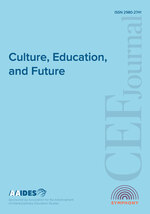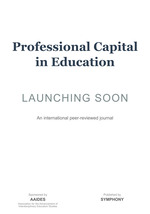© 2025
Editorial and Publishing Process
Review of Comparative and International Education (RCIE) maintains rigorous editorial standards through a comprehensive peer review process designed to ensure the highest quality of scholarly publications. Our transparent workflow supports authors throughout their submission journey while upholding international publishing standards.
Manuscript Submission Process
Initial Submission and Screening
All manuscripts must be submitted through our Open Journal Systems (OJS) platform, where authors receive automated confirmation upon submission. Complete submissions require a manuscript file, title page, cover letter, author declarations, and any additional documentation when applicable.
Our initial screening process evaluates submissions based on:
- Scope alignment with journal aims and objectives
- Adherence to submission guidelines and formatting requirements
- Completeness of documentation including all required forms
- Basic quality assessment covering language, structure, and academic merit
Timeline: Initial editorial decision typically within approximately two weeks of submission.
Editorial Review Process
Editorial Assignment and Decision Making
The Editor-in-Chief assigns manuscripts to appropriate editors based on subject expertise and manuscript complexity. For specialized topics, manuscripts are directed to relevant Section Editors; for broader submissions, Associate Editors handle the evaluation. All assigned editors conduct preliminary evaluation for scope and quality, with support from Assistant and Associate Editors as needed. The Managing Editor coordinates the editorial workflow throughout the process to ensure smooth operations.
Editorial decisions at this stage include:
- Desk Reject - Manuscript does not meet basic criteria or scope requirements
- Send to Review - Manuscript proceeds to peer review process
- Invite Revision - Minor issues requiring correction before review
Peer Review Process
Reviewer Selection and Assignment
RCIE employs a double-blind peer review system as the standard for all submissions, ensuring both author and reviewer anonymity throughout the process. We maintain an international reviewer pool to ensure diverse perspectives and expertise.
Our reviewer selection criteria include:
- Subject matter expertise and publication history in relevant fields
- Absence of conflicts of interest with authors or institutions
- Geographic and institutional diversity to ensure balanced perspectives
- Previous review quality and timeliness when applicable
Review Timeline: Initial reviewer invitations are sent promptly following editorial decision, with review completion typically expected within 4-6 weeks of acceptance. Extension when needed: Additional time may be granted when reviewers request extension due to justified circumstances. Backup reviewers are contacted if initial reviewers decline or face delays.
Review Criteria and Assessment
Reviewers conduct comprehensive evaluations using detailed assessment criteria:
Presentation and Writing Quality: Reviewers assess general readability, organization and efficiency, focus and clarity of written expression, creativity of expression, grammar, spelling, punctuation, academic writing style, and APA 7 format compliance (citations, references, tables, figures).
Introduction and Literature Review: Evaluation includes problem presentation and research objectives, subject importance and relevance, scope and timeliness of relevant literature review, and overall study originality and contribution.
Methodology: Assessment covers the suitability of research methods employed, research group selection and characteristics, validity and reliability of measurement tools, and appropriateness of data collection and analysis processes.
Results: Review focuses on clear presentation of findings within the methodological framework, accuracy of data analysis, quality and clarity of tables and figures, and appropriate use of visual presentations.
Discussion and Conclusions: Evaluation includes relevance of discussion to research questions or hypotheses, assessment of findings' generalizability and applicability, evaluation of the study's originality and contribution to literature, and implications for field practices.
Decision Categories and Process
Following comprehensive review, editors make decisions based on reviewer recommendations and editorial assessment:
- Accept for Publication - Manuscript approved with minimal or no changes required
- Minor Revision - Small modifications needed, reviewed by editors upon resubmission
- Major Revision - Substantial changes required, returns to peer review process
- Reject - Manuscript not suitable for publication in current form
- Submit Elsewhere - Content outside journal scope, leading to rejection
Decision Timeline: Standard review process typically takes 8-12 weeks from submission to first decision.
Revision and Re-review Process
Author Guidelines for Manuscript Revisions
Authors submitting revised manuscripts must provide a comprehensive response letter addressing each reviewer comment and editorial suggestion. All modifications must be clearly marked using track changes or similar methods. We allow reasonable time for revisions, typically several weeks to months depending on the scope of required changes. Extension requests are generally viewed favorably when justified circumstances are presented.
Re-review Procedures
Minor revisions undergo editorial review only, ensuring efficient processing of small corrections. Major revisions return to original reviewers when possible to maintain continuity in the review process. When original reviewers are unavailable, new qualified reviewers are assigned. Final decisions are made in reasonable timeframe following resubmission.
Quality Assurance and Publication Standards
Pre-Publication Quality Checks
Our quality assurance process includes:
- Plagiarism screening using professional detection software for all manuscripts
- Reference validation ensuring proper citation formatting and accuracy
- Final editorial review and formatting verification using provided templates
- Quality control for language, formatting, and academic standards
Post-Acceptance Production Process
Production Timeline: Accepted manuscripts are typically published online within several weeks of acceptance, either as early view articles or in the next appropriate issue, depending on production schedule and editorial workflow.
The production process includes:
- Publication license agreement and final documentation completion
- Final editorial review and template-based formatting verification
- Author proof review with reasonable time for approval
- DOI assignment and comprehensive metadata preparation
- Online publication shortly after final approval and formatting
Communication and Support
Our editorial office maintains regular communication with authors through automated system notifications, responsive communication for inquiries, online status tracking, and clear guidance throughout the editorial process. We also acknowledge the vital contribution of our reviewers by providing professional certificates upon request for career portfolios.
To maintain quality and relevance, our editorial processes undergo regular review and improvement based on author and reviewer feedback, industry best practice updates, COPE adherence standards, and ongoing evaluation of technology systems to enhance functionality and user experience.
This comprehensive approach aims to ensure that Review of Comparative and International Education maintains the highest standards of scholarly publishing while providing transparent, efficient, and supportive processes for all stakeholders in the academic community.
Editorial Office Contact:
- Email: journals@symphonypub.com







